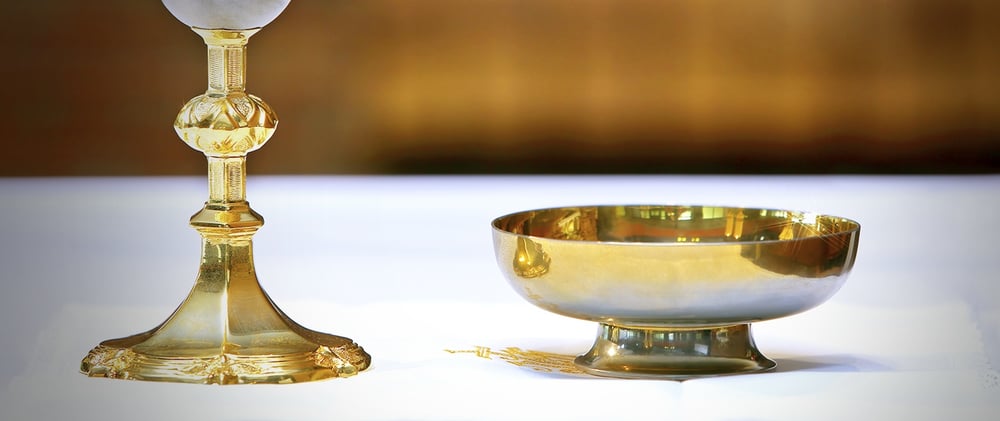Sacred vessels pictures

Priest’s Chalice – The priest will use the Chalice on the during the Eucharistic prayer.

Communion Cup – The cup used at mass to serve the Blood of Christ by the priest(s), deacon(s), and Extraordinary Ministers of Holy Communion (EMHCs).

Ciborium – The large vessel (with a lid not shown) is used to hold the Blessed Sacrament in the tabernacle. The small vessel is used to serve communion.

Purificator – This is a triple-folded, rectangular, white cloth used to cleanse the chalice and to dry the celebrant’s fingers after the last abulation (washing) during the Washing of the Hands.

Corporal – A white, linen napkin, usually starched, on which are placed the vessels containing the bread and wine during mass. It is folded into a small square. When unfolded, it is placed on top of the altar cloth.


Monstrance (left) – This is a large ornate vessel used to hold the Blessed Sacrament for Benediction and Eucharistic processions .
Lunette (right) – A thin, circular receptacle, having a glass face that holds the Consecrated Host used at Benediction. It slides into the monstrance on a track.

Pyx – A pocket watch–shaped case in which Communion is kept to distribute during sick calls.

Aspergillum (the thing with the handle and ball on top) – Also called the holy water sprinkler, it is a perforated metal ball or tube on a handle that holds holy water used by the priest to sprinkle the faithful or articles to be blessed. It is often kept in a small bucket (with a handle) that holds holy water.
Aspersorium – the pail or bucket used to hold that water.
 Thurible – The metal container extended from a chain in which charcoal is burned for liturgical ceremonies. It has a lid that can be raised.
Thurible – The metal container extended from a chain in which charcoal is burned for liturgical ceremonies. It has a lid that can be raised. 
Boat – This is a small metal container that holds the incense to be put into the thurible. It has a cover and comes with a small spoon.

Setting up the vessels for the celebration of the Lord’s Supper is an intricate task that requires much attention to detail. One must understand the types of sacred vessels and their purposes as well as where they should be placed on the altar. Here is a guide to arranging the sacred vessels, adapted from What an Altar Guild Should Know by Paul H. D. Lang.
Veiling the Chalice before the Service
Before the Holy Communion service, the chalice is veiled in the sacristy as follows:
- A folded purificator (small napkin) is laid over the mouth of the chalice to hang over the edges on the right and left sides.
- The paten is laid on the purificator.
- The pall (square of stiff material) covers the paten.
- The chalice veil covers all.
- The burse (envelope-like case) is laid on the chalice veil. Inside the burse is the corporal (linen on which the Communion vessels stand), a supply of purificators, and the post-Communion veil.
Placing the Vessels on the Altar before the Service
If the veiled chalice is placed on the altar by the pastor before the service, the following should be done:
- The corporal is taken out of the burse and placed on the altar.
- The veiled chalice is put on the corporal.
- The burse is set upright against the shelf at the back of the altar, close to the left of the chalice.
- Until the Offertory, the other vessels usually remain on the credence (linen covering the surface the bread and wine rest on before Communion).
However, when the other vessels are placed on the altar before the service, the flagon stands on the corporal behind and to the right of the veiled chalice, and the ciborium stands on the corporal behind and to the left of the veiled chalice.
Arranging the Vessels during the Offertory
When the chalice is unveiled during the Offertory, the position of the sacred vessels on the corporal becomes this:
- The paten or ciborium is placed on the center forepart of the corporal.
- The chalice is set behind the paten or ciborium.
- The wine cruets or flagon are set behind the chalice.
This arrangement may be used instead:
- The chalice and flagon are placed on the right side of the corporal with the chalice in front.
- The paten and ciborium are placed on the left side of the corporal with the paten in front.
If all of the vessels except the chalice are placed on the credence, they may be prepared as such:
- The ciborium is filled with wafers or hosts.
- The flagon is filled with wine.
- The water cruets (if used) are filled with water.
- All vessels are set on the credence, the flagon to the right and the ciborium to the left.
- Behind them are placed the water cruets and the lavabo bowl and towel, if they are used.




Leave a Reply